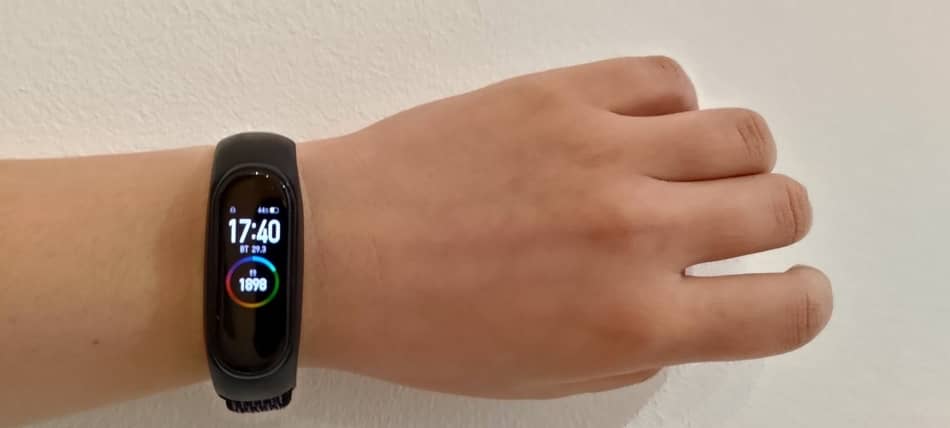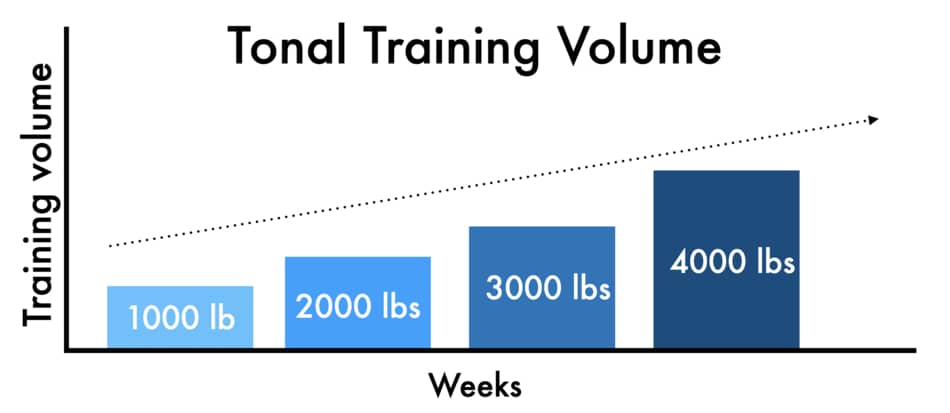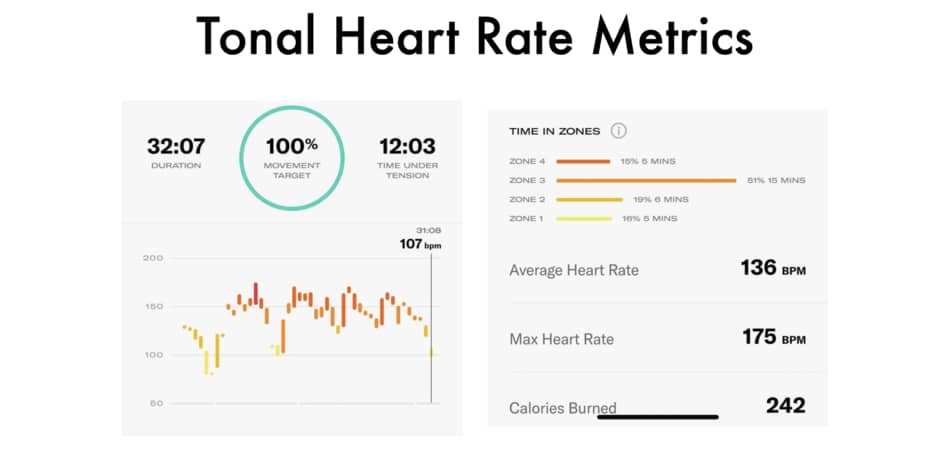One of the smartest things you can do to track your performance and exercise intensity with every Tonal workout is using a heart rate monitor. Today I want to unpack everything there is to know about the Tonal heart rate monitor, how it works, and most importantly, how to use it based on your fitness goals.
As a whole, Tonal does allow you to track your heart rate using HRM like Garmin, Polar, Apple Watch, or Scosche. It not only displays your average heart rate from the whole workout but also segments the class intensity into five heart rate zones, which shows you how hard you have been working out.
I will also touch on the heart rate zones and the differences between them.

Tonal With Heart Rate Monitor
Tonal is doing an amazing job not only at tracking metrics like time under tension or total pounds lifted after each session but also in using this data to further personalize your workout programs via smart AI technology and algorithms.
Here’s the catch.
These training suggestions are mainly based on the metrics like power output that you generate while lifting weights and accelerometers in the handles to calculate how easy or how hard was that last rep and adjusts the resistance accordingly.
In other words, Tonal keeps tracking your training volume to design your future workouts.
However, one metric that has been underrated (yet very important in tracking performance and intensity) is heart rate. Heart rate is one of the metrics that Tonal algorithms do not include in their workout personalization.
Big mistake.
Before I show you why using a heart rate monitor on Tonal is important, let’s have a look at why Tonal does not include this metric in their AI algorithms.
Is Using a Heart Rate Monitor with Tonal Effective?
Overall, using a heart rate monitor with Tonal is an effective way to track your intensity, however, it is not useful if your goal is to build strength and muscle mass. The best way to track your results in regards to hypertrophy and strength is by watching your total training volume.
What is training volume? In short, training volume on Tonal describes how much weight you lift during the course of a day, week, or month. It is calculated based on the number of sets, reps, and resistance. For example, doing barrel squats with 100lbs for 10 reps gives you 1000lbs of total training volume.
See the graph below.

As you can see above, adding one extra set each week to the barrel squat while keeping the same amount of resistance increases the total training volume from week to week. This is one of the most effective ways to create progressive overload, elicit hypertrophy, and strengthen the muscle.
Studies have shown that “training volume (also called volume load) was found to be strongly associated with changes in 1RM (one repetition maximum) for both males and females, controlling for age, body mass, and baseline strength” (Peterson et al. 2011).
Adding more resistance over time influences the adaptation of muscle and avoids the plateau.
On the other hand, measuring training intensity in the form of heart rate is not typically used as a way to monitor and track the strength progress.
(that’s why Tonal keeps heart rate only as an additional metric and doesn’t include it in their training recommendations).
Using heart rate as an intensity indicator is typically done with aerobic exercises like running, swimming, or cycling because it’s easier to maintain the same pace and stay within the desired heart rate zone (I will explain more about the heart rate zones in a moment).
For example, people who want to maximize fat oxidation (burning more calories from fat, instead of carbohydrates) should keep the intensity lower (around 60-70% of maximum heart rate) and extend the duration of the workouts.
Studies have shown that “Maximal fat oxidation lies between 60.2% and 80.0% of the maximal heart rate” (Carey, 2009).
Of course, you still burn a lot of calories by building muscle and strength because they both increase your basal metabolic rate. However, burning calories and staying within a certain heart rate is not what Tonal is all about.
Also, please remember that lifting heavier weights or extending time under tension does elicit a higher heart rate, however, it’s hard to control and maintain the specific level of intensity around desired heart rate zone.
The good news is that you can use Tonal for strength and cardio simultaneously (e.g. circuit training) to build muscle and burn, and use heart rate monitors to track how hard you train.
Key Takeaways:
- For strength and muscle size, focus on training volume and progressive overload
- For fat-burning and aerobic fitness, focus on training intensity and heart rate zones
Can You Use Heart Rate Monitors With Tonal?
In general, you can use Tonal with a heart rate monitor not only to track your performance but also to navigate your workout intensity to achieve specific outcomes based on your fitness goals. The Tonal touchscreen shows you real-time feedback and automatically saves the data into your Tonal Activity history.
See below.

As you can see, in your Tonal Activity graph you can see the number of metrics that are derived from the heart rate.
- Overall graph – In the overall graph, you see how does your heart rate change throughout the whole workout. This is good to know because you can see which types of exercises and/or exercise combinations lead to these changes.
In general, most compound movements like squats, bench presses, deadlifts, and overhead presses use multiple muscle groups, therefore, eliciting higher heart rate, versus isolation exercises like cable flyes or biceps curl.
- Average heart rate – These numbers show you your average intensity throughout the whole class. I like to use average heart rate to compare my workouts.
- Max heart rate – Maximum heart rate on the Tonal Activity graph shows you what was your peak heart rate and (from the graph on the left) you can see at which moment during the class you reached this number.
That is a great metric if you want to reverse engineer your session and figure out which exercises lead to the highest heart rate (or the lowest).
- Calories burned – Tonal uses your heart rate readings to estimate your calorie expenditure for each session. However, this formula has limitations, which makes it inaccurate.
Several factors can influence heart rate levels, even without being physically active.
Here is the list:
| Factors | Description |
|---|---|
| Heat | Exercising in a humid and/or hot place can increase resting heart rate. |
| Hydration | Lack of water can decrease blood volume, therefore, resulting in a faster heartbeat and higher heart rate. |
| Lack of sleep | Inadequate sleep and abrupt awakenings can lead to an increase in heart rate. |
| Stress | Stress releases adrenaline and cortisol, which temporarily causes the heart rate to increase and blood pressure to rise. |
| Caffeine | Caffeine increases adrenaline and mildly increases the heart rate. |
| Pre-workouts | Pre-workouts contain caffeine and taurine |
| Nicotine | Research has shown that smoking increases heart rate and can cause an irregular heart rhythm |
| Medications | Certain medications can influence your heart rate |
As you can see, a higher heart rate doesn’t always correspond to more calories burned.
The Tonal heart rate monitor is an excellent way to measure heart rate. However, the heart rate itself isn’t the most accurate way to estimate calories burned.
Does Tonal have a heart rate monitor? As a whole, the Tonal does not have its own heart rate monitor available for sale. However, it is compatible with most of the popular heart rate monitor brands like Polar, Garmin, Whoop, Scosche, Fitbit, and Apple Watch, as long as they use Bluetooth.
The last metric on the Tonal activity graph is “time in zones” which shows you the time measured in minutes that you spend in each of the heart rate zones.
Tonal Heart Rate Zones
Tonal heart rate zones (and all of their training recommendations) are in line with the current ACSM guidelines, which are based on the percentage of personal maximum heart rate. The maximum heart rate is calculated using the standard formula 220 – your age.

However, multiple studies have shown that “this equation has been reported to have a standard deviation of between 10 and 12 bpm, as well as significantly over and underestimating HRmax in younger and older adults” (Tanaka et al. 2001).
(Please keep in mind that you can manually adjust your maximum heart rate in the Tonal settings).
How To Make Tonal Heart Rate Zones More Accurate?
As a whole, you can make Tonal heart rate zones more accurate by adjusting your maximum heart rate in the Tonal settings using one of the equation formulas that are specific to your age.
If you really want to split the hair (and get the most accurate metrics), below you can find the list of equations based on your age that is in line with the latest research.
| Equation | Formula | Population | Source |
|---|---|---|---|
| Tanaka | HRmax = 208 – 0.7 x Age | 18–25-year-olds | Roy, and McCrory, 2015 |
| Tanaka | HRmax = 208 – 0.7 x Age | Older adults | Roy, and McCrory, 2015 |
| Nes | HRmax = 211 – 0.64 x Age | Active adults | Nes, et al. (2013) |
| Heinzmann-Filho | HRmax = 200 – 0.48 x Age | Obese adults | Heinzmann-Filho et al. (2018) |
As you can see, the equation slightly changes based on the activity level, population, and age.
To make the heart rate zones on Tonal more accurate you need to choose the equation that corresponds with you and input the results in your Tonal profile settings.
How do Tonal Heart Rate Zones Works?
As a whole, the Tonal heart rate zones work as a guide to determine the intensity of the exercise and help you to get the most out of your workouts. Heart rate zone training helps to know when to increase or decrease the intensity, based on your personal goals, as well as provide you with real-time feedback.
To know your heart rate zones you need to wear a heart rate monitor either strapped around your chest or worn on the arm or wrist. The Tonal will automatically transmit the signal from the HRM into the machine and display your heart rate zones.
In total, there are five heart rate zones on Tonal.
| Tonal heart rate zones | % of maximum heart rate |
|---|---|
| Zone 1 | 50-60% |
| Zone 2 | 60-70% |
| Zone 3 | 70-80% |
| Zone 4 | 80-90% |
| Zone 5 | 90-100% |
What should my heart rate zones be? As a whole, your Tonal heart rate zones should match your personal goals. For example, if your goal is to improve your 5K running and have a higher power output, your workouts should be done in the higher zones using interval training.
On the other hand, if your goal is to improve your running endurance, your desired heart rate zones should be lower.
How Much Time Should I Spend In Each Heart Rate Zone?
In general, the time spent in each Tonal heart rate zone will depend on the workout type and duration. Most of the HIIT and Bootcamp workouts are performed in zone 3 and 4, where most of the strength classes can include a combination of all heart rate zones.
Here is the list of the Tonal heart rate zones together with the duration, recommended by Andrew R. Coggan, Ph.D.
| Peloton Heart Rate Zones | Duration |
|---|---|
| Zone 1 | Up to 1 hour |
| Zone 2 | Up to 3 hours |
| Zone 3 | Up to 90 minutes |
| Zone 4 | 3 to 8 minutes intervals |
| Zone 5 | 10 seconds sprints |
Each of the heart rate zones comes with different benefits. For example, people who train for endurance should spend 70-80% of the days in Zone 2, whereas people who train for 100m sprints should include more Zone 4 and 5 work.
I personally like to train in Zone 2 because this intensity is the best at stimulating mitochondrial function (you feel more energized), fat oxidation (weight loss), and lactate cleanse capacity (improved recovery).
Benefits of Using Tonal With Heart Rate Monitor
Here you can watch the video from Tonal coach Jared where he explains the benefits of using Tonal with heart rate zones.
Best Heart Rate Monitor For Tonal
Here is the list of the best heart rate monitors that are compatible with Tonal.
- Apple Watch
- Garmin
- Scosche
- Polar
- Whoop
- Fitbit
As you can see, the Tonal gym is compatible with most heart rate monitors that use Bluetooth and ANT+ technology. I personally use Tonal with Polar H10.
How To Pair Tonal With Heart Rate Monitor
You can pair Tonal with a heart rate monitor directly from the Tonal interface. Here are the step-by-step instructions on how to connect Tonal with your HRM.
- Open the “Settings” tab on Tonal
- Select the “Bluetooth” tab
- “Turn on” the Bluetooth tab in the top left corner
- Tap “Pair Bluetooth Device”
- Find the name of your heart rate monitor to connect (Tonal should detect and display nearby Bluetooth devices).
One thing that I like about the Tonal is once I sync my heart rate monitor with the machine it will start to remind me to put it on for every next workout. As soon as I do it, within a few seconds, my heart rate monitor connects and the class starts.
Tonal Heart Rate Monitor Troubleshooting
If you have problems with pairing your heart rate monitor with Tonal you can use an alternative way via Apple Watch.
For example, if you’re using the chest strap HRM like Polar H10 you can connect it with Apple Watch under the Bluetooth settings and then pair the watch back to the Tonal. Now, you can use the Tonal Watch app like before and the heart rate info comes from the Polar, rather than the Watch, and the app calculates calories like before.
Tonal Without Heart Rate Monitor
You can use Tonal and track your performance without a heart rate monitor. To do this you can use tried and tested RPE scale (rated perceived exertion) as well as breathing rate.
For example, if you train in heart rate zones 1, 2, and 3 you should be able to maintain a regular breathing rate where continuous conversation is still possible. However, if your breathing rate is high enough to keep you out of breathing where you can no longer maintain a conversation, you are likely tapped in the heart rate zone 4 and 5.
Do You need a heart rate monitor for Tonal? In general, you do not need to use a heart rate monitor with Tonal if your goal is to only track the training load and volume. However, you do need a heart rate monitor with Tonal if you want to be able to track the performance and intensity of your training.
Conclusion
As you can see, I’m a huge fan of using heart rate monitors because it is the easiest way to keep an eye on your intensity and adjust your workouts based on your personal goals.
You can use a heart rate monitor with Tonal not only to track your intensity but also to measure your calories burned. One thing I don’t like is Tonal does not make any training intensity suggestions or heart rate zone recommendations, even if my goal is to burn more calories per workout.
On the other hand, what I like about the Tonal is it shows you the summary of your workout heart rate in its recaps results. From there, it helps you to make a clear decision on how to optimize your training by comparing your performance week by week.
